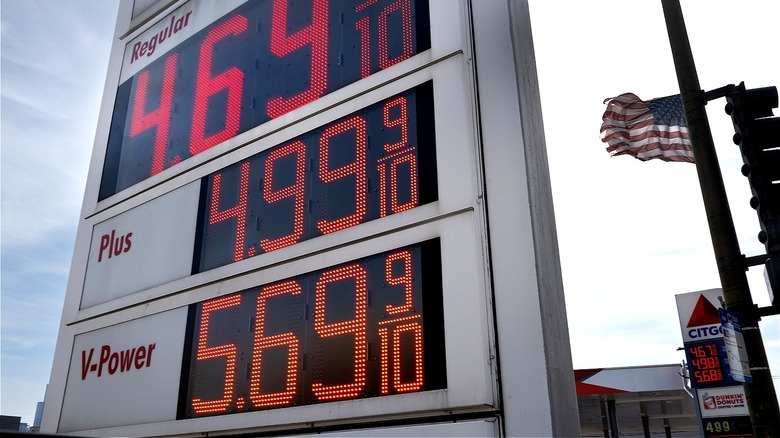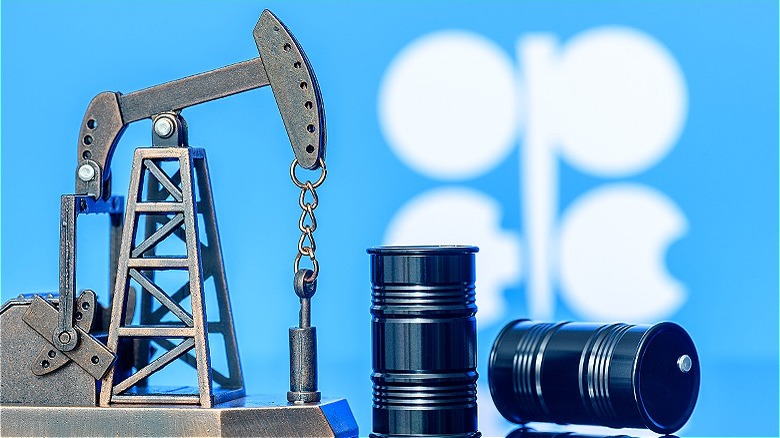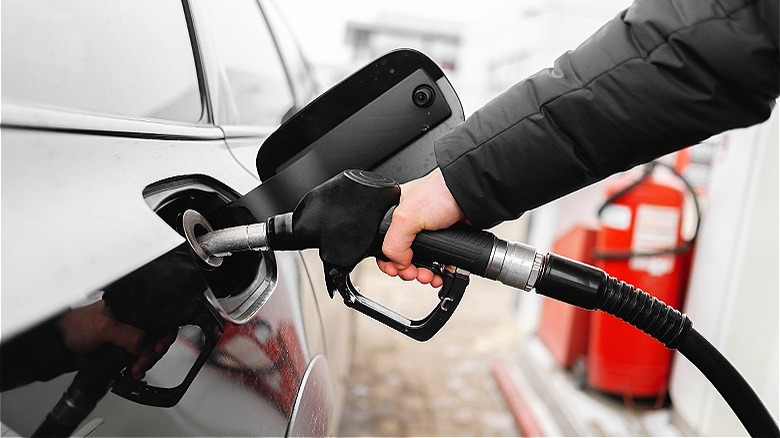What Actually Controls The Price Of Gas In The US?
Between keyboard warriors and comments sections, you might have noticed conflicting (and sometimes even downright incorrect) information about how, exactly, gas prices work in America today. While some popular opinions involve blaming whatever the current administration is for increases in gas prices, the issue is far more complicated than any singular person or even any singular government. In fact, the Energy Information Administration identifies four major factors that directly correlate to the cost of gas (and none of them are the president). These factors are crude oil prices (which are set by oil-producing countries), refining costs (which are increasingly impacted by natural disasters and climate change), distribution and marketing costs (which depend on the individual retailer you purchase gas from), and taxes (federal, state, and local taxes and fees).
For starters, you've probably heard terms like crude oil and petroleum come up in the gas conversation. For anyone who might not know, the gasoline we currently commercially purchase for our cars (or any other vehicle) is essentially a blend of crude oil and other petroleum liquids. Petroleum refineries break down crude oil into various components in order to then reconfigure and blend them into fuel products. This refinery process is extremely important, with this factor comprising 14% of your per-gallon price at the pump. Refinery costs are impacted by demand (with summer usually the highest-demand season) as well as by climate change. Since most United States refineries are located along the Gulf Coast, this generally means hurricanes, a natural disaster that can destabilize the stock market, and by extension, the economy.
OPEC
While there are four different factors that ultimately influence gasoline prices, the price of crude oil is far and away the biggest contributing factor. In fact, according to the EIA, crude oil prices make up 54% of what you end up paying per gallon at the pump. The biggest deciding body in these crude oil prices is the Organization of the Petroleum Exporting Countries, or OPEC as it's more commonly referred to. OPEC is an organization composed of 13 countries (however, the organization is led by Saudi Arabia) that control roughly 60% of the world's traded petroleum supply. As a cartel, OPEC not only controls the supply of most of the world's oil but is also directly responsible for regulating and, increasingly, manipulating oil prices.
It's important to realize that even though the U.S. is the world's largest oil producer, the country ultimately imports more crude oil than it exports, leaving prices vulnerable to the global market (which is largely controlled by OPEC). This means that price manipulations from OPEC heavily impact gas prices across the country, and even prices depending on the day of the week (the cheapest day to buy gas is Monday, by the way), with the U.S. having very little power to influence those prices.
If you're wondering why the U.S. can't simply bypass OPEC for oil, it is worth noting that the next highest oil-producing countries outside of the U.S. and OPEC are Russia and China. As international relations with both of those countries continue to grow more challenging, any ability to rely on them for a stable oil supply is increasingly unlikely.
Your individual costs
Two of the four major factors contributing to gas prices can and do vary quite significantly at the individual level. For starters, the tax rate on gasoline in your specific state, county, and/or city can have a lot to do with how much you might pay at the pump (the EIA estimates taxes make up 16% of what you ultimately pay). The federal government taxes 18.4 cents on every gallon of gasoline while, as of July 2022, state taxes on gasoline average around 32 cents per gallon. It's also worth mentioning that the sales tax in your local area can also impact your gas prices.
The other factor depends on just what gas station you go to. You might not be aware of this, but each individual gas station can have drastically different ownership models. Some gas stations might be owned and operated directly by refiners while others could be independent or franchise businesses that resale purchased gasoline directly to the public. This is important because the distribution, marketing, and general retail costs associated with getting the gasoline to you ends up being 16% of your gasoline price. Refinery-owned stations might receive their product via pipeline as opposed to individually owned stations needing to rely on tanker trucks. Plus, smaller independent stations are more likely to have higher overhead costs for things like wages, rent, insurance, and fees. This is why two gas stations on the same street can have wildly different prices, and why it can pay to know some tricks for saving money on gas.


